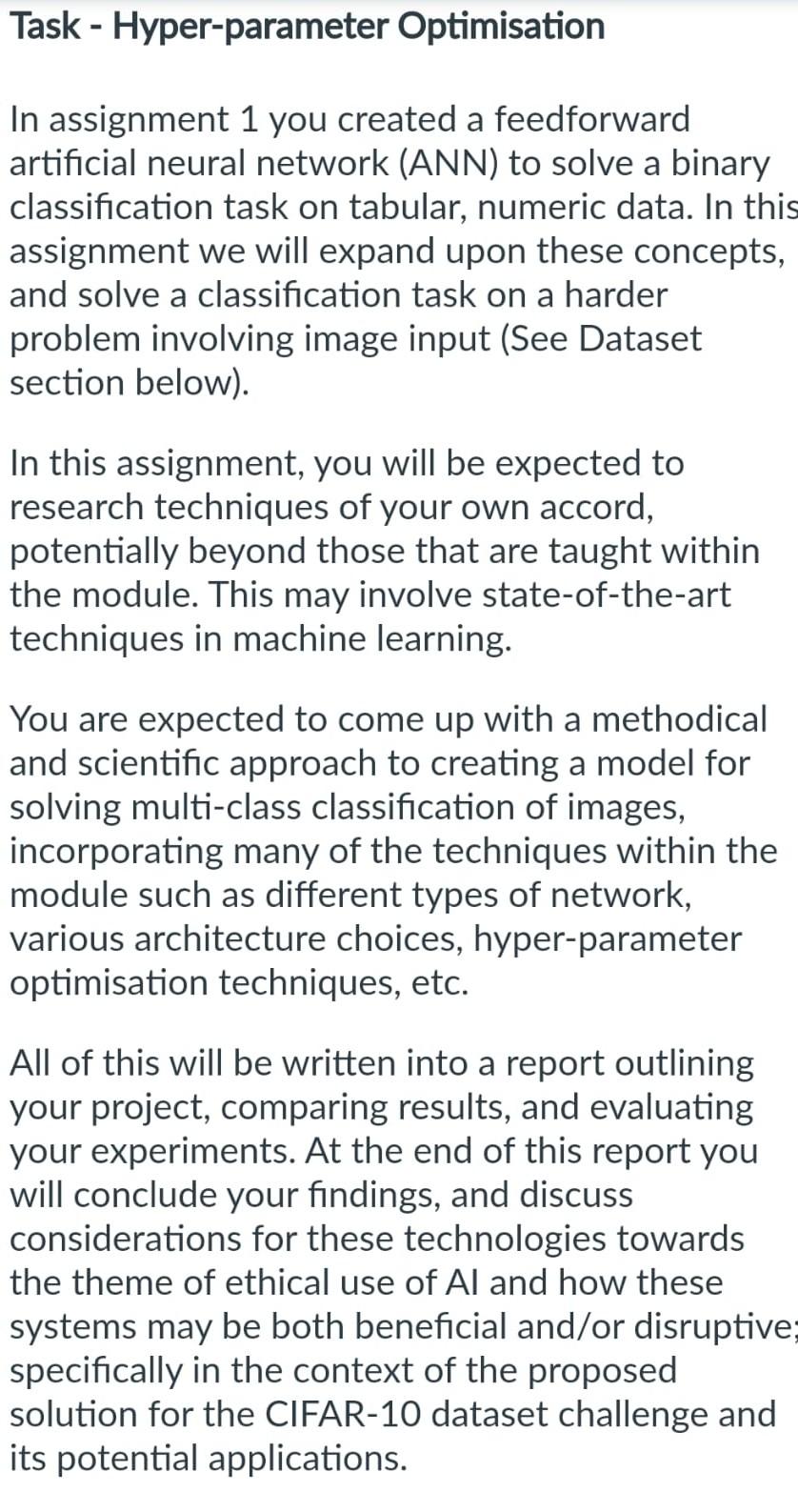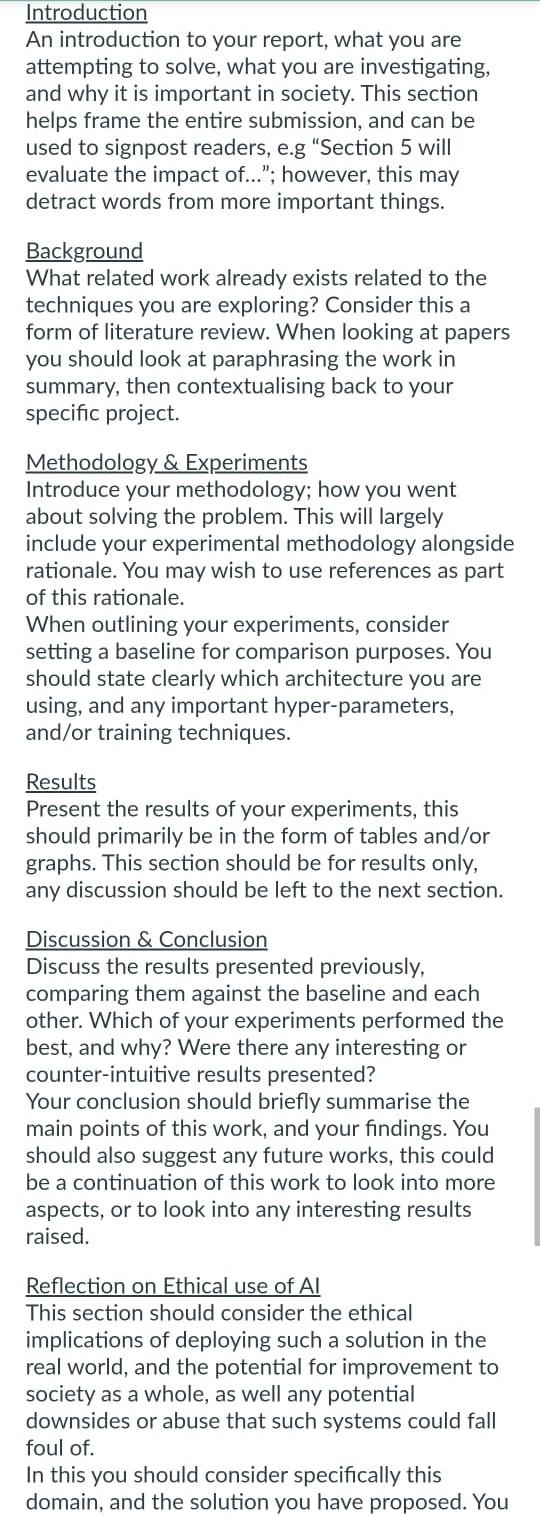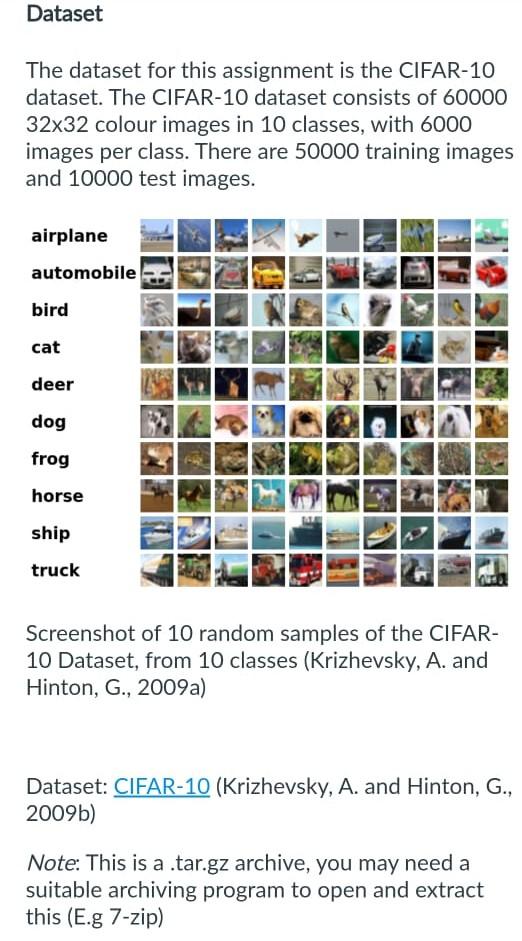Answered step by step
Verified Expert Solution
Question
1 Approved Answer
In need every step of this answer to be solved as soon as possible please answer it with detail Task - Hyper-parameter Optimisation In assignment




In need every step of this answer to be solved as soon as possible please answer it with detail
Task - Hyper-parameter Optimisation In assignment 1 you created a feedforward artificial neural network (ANN) to solve a binary classification task on tabular, numeric data. In this assignment we will expand upon these concepts, and solve a classification task on a harder problem involving image input (See Dataset section below). In this assignment, you will be expected to research techniques of your own accord, potentially beyond those that are taught within the module. This may involve state-of-the-art techniques in machine learning. You are expected to come up with a methodical and scientific approach to creating a model for solving multi-class classification of images, incorporating many of the techniques within the module such as different types of network, various architecture choices, hyper-parameter optimisation techniques, etc. All of this will be written into a report outlining your project, comparing results, and evaluating your experiments. At the end of this report you will conclude your findings, and discuss considerations for these technologies towards the theme of ethical use of Al and how these systems may be both beneficial and/or disruptive specifically in the context of the proposed solution for the CIFAR-10 dataset challenge and its potential applications. Introduction An introduction to your report, what you are attempting to solve, what you are investigating, and why it is important in society. This section helps frame the entire submission, and can be used to signpost readers, e.g "Section 5 will evaluate the impact of..."; however, this may detract words from more important things. Background What related work already exists related to the techniques you are exploring? Consider this a form of literature review. When looking at papers you should look at paraphrasing the work in summary, then contextualising back to your specific project. Methodology \& Experiments Introduce your methodology; how you went about solving the problem. This will largely include your experimental methodology alongside rationale. You may wish to use references as part of this rationale. When outlining your experiments, consider setting a baseline for comparison purposes. You should state clearly which architecture you are using, and any important hyper-parameters, and/or training techniques. Results Present the results of your experiments, this should primarily be in the form of tables and/or graphs. This section should be for results only, any discussion should be left to the next section. Discussion \& Conclusion Discuss the results presented previously, comparing them against the baseline and each other. Which of your experiments performed the best, and why? Were there any interesting or counter-intuitive results presented? Your conclusion should briefly summarise the main points of this work, and your findings. You should also suggest any future works, this could be a continuation of this work to look into more aspects, or to look into any interesting results raised. Reflection on Ethical use of Al This section should consider the ethical implications of deploying such a solution in the real world, and the potential for improvement to society as a whole, as well any potential downsides or abuse that such systems could fall foul of. In this you should consider specifically this domain, and the solution you have proposed. You In this you should consider specifically this domain, and the solution you have proposed. You may wish to include academic references here for additional support and framing of the wider context and/or examples of existing systems of abuse. References Substantial number of relevant literature references, these should be more than those provided in the module, and from your own reading. Note, do not include references here if you have not used them in the main body of the report (ie. in-text citations etc). When making reference to the Dataset itself you should use the following reference: Krizhevsky, A. and Hinton, G., 2009. Learning multiple layers of features from tiny images. Dataset The dataset for this assignment is the CIFAR-10 dataset. The CIFAR-10 dataset consists of 60000 3232 colour images in 10 classes, with 6000 images per class. There are 50000 training images and 10000 test images. Screenshot of 10 random samples of the CIFAR10 Dataset, from 10 classes (Krizhevsky, A. and Hinton, G., 2009a) Dataset: CIFAR-10 (Krizhevsky, A. and Hinton, G., 2009b) Note: This is a .tar.gz archive, you may need a suitable archiving program to open and extract this (E.g 7-zip) Task - Hyper-parameter Optimisation In assignment 1 you created a feedforward artificial neural network (ANN) to solve a binary classification task on tabular, numeric data. In this assignment we will expand upon these concepts, and solve a classification task on a harder problem involving image input (See Dataset section below). In this assignment, you will be expected to research techniques of your own accord, potentially beyond those that are taught within the module. This may involve state-of-the-art techniques in machine learning. You are expected to come up with a methodical and scientific approach to creating a model for solving multi-class classification of images, incorporating many of the techniques within the module such as different types of network, various architecture choices, hyper-parameter optimisation techniques, etc. All of this will be written into a report outlining your project, comparing results, and evaluating your experiments. At the end of this report you will conclude your findings, and discuss considerations for these technologies towards the theme of ethical use of Al and how these systems may be both beneficial and/or disruptive specifically in the context of the proposed solution for the CIFAR-10 dataset challenge and its potential applications. Introduction An introduction to your report, what you are attempting to solve, what you are investigating, and why it is important in society. This section helps frame the entire submission, and can be used to signpost readers, e.g "Section 5 will evaluate the impact of..."; however, this may detract words from more important things. Background What related work already exists related to the techniques you are exploring? Consider this a form of literature review. When looking at papers you should look at paraphrasing the work in summary, then contextualising back to your specific project. Methodology \& Experiments Introduce your methodology; how you went about solving the problem. This will largely include your experimental methodology alongside rationale. You may wish to use references as part of this rationale. When outlining your experiments, consider setting a baseline for comparison purposes. You should state clearly which architecture you are using, and any important hyper-parameters, and/or training techniques. Results Present the results of your experiments, this should primarily be in the form of tables and/or graphs. This section should be for results only, any discussion should be left to the next section. Discussion \& Conclusion Discuss the results presented previously, comparing them against the baseline and each other. Which of your experiments performed the best, and why? Were there any interesting or counter-intuitive results presented? Your conclusion should briefly summarise the main points of this work, and your findings. You should also suggest any future works, this could be a continuation of this work to look into more aspects, or to look into any interesting results raised. Reflection on Ethical use of Al This section should consider the ethical implications of deploying such a solution in the real world, and the potential for improvement to society as a whole, as well any potential downsides or abuse that such systems could fall foul of. In this you should consider specifically this domain, and the solution you have proposed. You In this you should consider specifically this domain, and the solution you have proposed. You may wish to include academic references here for additional support and framing of the wider context and/or examples of existing systems of abuse. References Substantial number of relevant literature references, these should be more than those provided in the module, and from your own reading. Note, do not include references here if you have not used them in the main body of the report (ie. in-text citations etc). When making reference to the Dataset itself you should use the following reference: Krizhevsky, A. and Hinton, G., 2009. Learning multiple layers of features from tiny images. Dataset The dataset for this assignment is the CIFAR-10 dataset. The CIFAR-10 dataset consists of 60000 3232 colour images in 10 classes, with 6000 images per class. There are 50000 training images and 10000 test images. Screenshot of 10 random samples of the CIFAR10 Dataset, from 10 classes (Krizhevsky, A. and Hinton, G., 2009a) Dataset: CIFAR-10 (Krizhevsky, A. and Hinton, G., 2009b) Note: This is a .tar.gz archive, you may need a suitable archiving program to open and extract this (E.g 7-zip)Step by Step Solution
There are 3 Steps involved in it
Step: 1

Get Instant Access to Expert-Tailored Solutions
See step-by-step solutions with expert insights and AI powered tools for academic success
Step: 2

Step: 3

Ace Your Homework with AI
Get the answers you need in no time with our AI-driven, step-by-step assistance
Get Started


